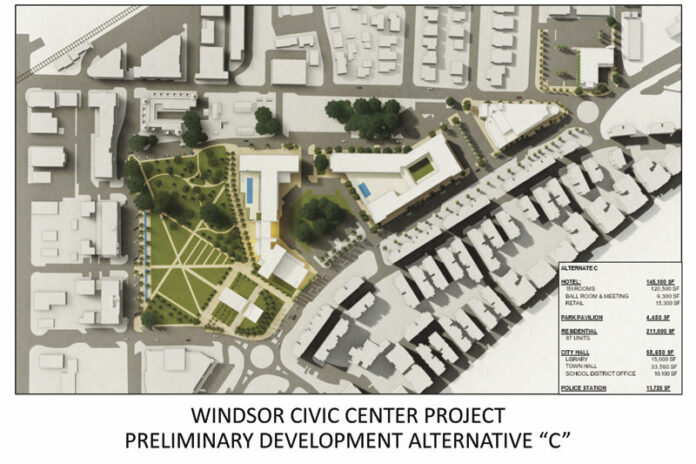In an eight part series we look back at the world that was, here in our little corner of it. 2020 was a year of challenges. We’ll be publishing this eight piece work daily as we work to the new year. Today’s piece is on the development that was discussed, started, completed and even argued about in Windsor this year.
The Town Green Civic Center Project
There is not a single issue which has driven a bigger wedge in the community of Windsor than the Town Green Civic Center project. On Jan. 22, community members, elected officials, various town staff members and other interested parties met with Robert Green of the Robert Green Company and members of their architectural firm BAR to have a preliminary look and conversation about the future of the north side of the Town Green and civic center.
The project encompasses the land on the northeastern side of the Green, including the areas currently occupied by the library, the police station, the Huerta gym, the civic center and the school district. In addition, Green is looking at purchasing another triangular sliver of land north of the current site currently owned by the Telford family, as well as another piece of Telford land across the street from that sliver.
In basic terms, the vision for the area is a 151-key hotel, with six restaurants (owned and branded by Green), a rooftop pool and bar, spa and significant conference and ballroom space. There will also be a housing unit, with furnished town homes and flats, and a new pavilion for entertaining and events.
On the Telford property, a new multi-story building will be constructed that will encompass the library, the civic center and the school district, while an additional piece of Telford land across the street will house the new police station.
The proposed design will preserve the community garden and the children’s play area, as well as the two significant oak groves currently in place, although one will now be located within the circular driveway between the two hotel and residences. There is significant parking within the structures as well as additional street spaces. A total of 495 parking spaces will be created with the project.
There are a variety of concerns expressed by town residents, including the future of the Huerta gym, the ownership of the new pavilion envisioned for the Town Green, and access to the oak groves. There were also questions about the current Sparks Memorial Pavilion, which was paid for by donations from local families to honor Windsor veterans. There were also concerns raised about enclosing the Green and altering traffic patterns, the fact that the civic buildings would now be located two blocks north of the Green rather than directly adjacent to it and whether or not the new vision is family-friendly enough.
However, those concerns pit the family-friendly crowd against businesses who are desperate for the customers the project would bring, and the entities like the library and police department who are desperate for more space.
At a Feb. 12 special meeting town staff provided information on the three options outlined for consideration, potential developer Robert Green did a reduced version of his informational presentation from Jan. 22 and an independent financial auditor gave a presentation regarding the financial feasibility of the project. But, a significant amount of the staff’s presentation was quelling rumors that had sprung up on social media regarding the project.
Once the town, developers and financiers had had their say, it was the community’s turn, as more than 41 people stood in line to give their opinion to the council. Among the commenters, there were 15 firm statements against, 17 firm statements for, and an additional nine who had a mixed response to the project, who liked some ideas and hated others.
The nays were primarily concerned with the scale of the project, the perception of the Town Green becoming a front yard for the hotel and residences, the fear that should the finances not come through the town would be left holding the bag without the promised civic center, or with a scaled down version of it, and that Windsor was in danger of becoming Healdsburg, which several residents defined as the town no longer existing for the residents, but only existing for tourists.
The yeas were primarily focused on the desperate need for foot traffic in the downtown and Town Green businesses, the need for all of the current civic center facilities to have upgraded and larger facilities that the town cannot otherwise pay for, the possibility of jobs for local contractors and tradesmen, and several speakers spoke on behalf on the library being in desperate need of a larger and upgraded space.
In the end, Bruce Okrepkie, Esther Lemus, Dominic Foppoli and Debora Fudge all voted in favor of moving to the next step, including choosing option C as the preferred option, though with a few possible changes the council wished to discuss further, namely whether the hotel should front directly on the Green or if there should still be a street all the way around the Green. Salmon voted against.
In May, in the wake of COVID The Robert Green Company and the town of Windsor have agreed to extend the length of the Exclusive Negotiating Agreement (ENA) for the civic center project for one year to allow both parties more time to consider the viability of the project in a COVID-19 world.
Ultimately the consensus was that the year should be granted, and they decided to connect it to a letter from the Windsor Unified School District, which was received on May 21, and affirms their interest in working with the town on the project. Therefore, the ENA now expires on May 21, 2021.
Lytton Tribe makes connections to Windsor
It’s been more than a decade since discussions began about what would happen to wastewater if the Lytton Tribe were to have their lands west of town put into federal trust. At its May 20 meeting, the Windsor Town Council voted unanimously to move forward to the next step, creating an agreement to have the wastewater treated in the town’s facility.
The issue has always been contentious, and while some of that spilled over into this meeting, the public sentiment this time flowed in favor of the plan.
The basic issue, as mentioned multiple times throughout the presentation and discussion, is that since the Lyttons are a sovereign nation, the town has virtually no say in what occurs on their land. Therefore, if the town and tribes cannot come to an agreement, the tribe is within their rights to construct their own facility at a location of their choosing, which was reported as immediately adjacent to the backside of the Deer Creek neighborhood.
The two options, on-site and connection to Windsor, shake out as follows.
The on-site option involves construction of wastewater treatment and disposal systems on their land. The tribe has indicated the wastewater treatment facility would be constructed north of Windsor River Road and west of the residential neighborhoods between Starr Road and the edge of town. The off-site option involves connection to the town’s wastewater system.
The concerns about the on-site facility delineated in the EA included “potential adverse impacts on drinking water quality resulting from the discharge into a drainage that ultimately flows to the gravel pits that are adjacent to the town’s Russian River Well Field. There are also concerns about impacts on the Mark West Creek/Laguna De Santa Rosa watershed resulting from the discharge into an unnamed tributary located along the eastern boundary of the project site, which flows into Windsor Creek south of the project site that connects to Mark West Creek and ultimately the Russian River.”
Other potential benefits of connecting with Windsor’s system include “avoiding potentially objectionable odors resulting from the treatment, storage and/or disposal of wastewater that could impact residential neighborhoods within town limits with prevailing westerly winds blowing odors across the town, avoiding spray of treated effluent in close proximity to residential neighborhoods and ensuring opportunities for beneficial re-use of treated wastewater, something the town currently does with its wastewater.
In exchange a $20 million “connection fee” to be paid by tribe to the town. The actually cost for these improvements is slated to cost $3.5 million, and the town will be free to utilize the remainder for a civic project of their choosing, such as a pool or recreation center. The costs of connecting each structure and the pipe work and infrastructure within the tribal lands will be paid for by the tribe separately.
Previous conversations about this issue have featured invective language against the tribe, characterized throughout the meeting with phrases like “quite offensive,” “embarrassing,” “hurtful” and “nasty.”
This time around, the arguments against the issue focused around a perceived lack of transparency from the council and concerns over the legality of the action and whether it needed to be approved by a vote of the people. Out of 11 public comments, four were against the council approving this agreement. However, the town manager presented significant evidence to support that a vote of the people was not needed in this case.
All-electric REACH code
Adopted in October of 2019, the REACH code ordinance, which became effective on Jan. 1, 2020, applies to the development of all new low-rise residential development, including single-family homes, detached accessory dwelling units and multi-family development up to three-stories in height. New low-rise residential development is required to use only electric appliances and mechanical systems; the use of gas appliances and mechanical systems is not allowed.
Following the adoption, the town had been sued by two developers and the agenda for this meeting announced a settlement agreement which included a full repeal.
However, in the wake of the agenda being published, there was a significant outpouring of support for the code, including a voluminous number of letters and several in-person comments. So, when the moment came early on to discuss changes to the agenda, Town Manager Ken MacNab suggested they push the decision off.
“Staff is recommending this item be continued,” he said. “It is related to the litigation on the town’s adoption of an all-electric reach code, and a continuance would give staff more time to review some of the legal points in the litigation that’s been filed.”
The council voted unanimously in favor of the continuance, and by the end of the year no final decision had been reached.
Multi-Family Residential Objective Design Standards project
Between May 12 and 14, the town and their consultants (Mintier Harnish and Orr Design) conducted three days of one‐on‐one and group interviews with local housing developers, landowners and other multi-family housing stakeholders to gain an understanding of the ideas and expectations of the housing development community.
The interviews included 11 participants. The input provided during the interviews helped to provide a starting point for drafting the multi-family residential objective design standards.
Next, a three-part community workshop series was held between Aug. 24 and Oct. 15 and included webinars on housing factors and design elements, followd by a visual preferenace survey.
The full findings of both the stakeholders interviews and the community workshop can be found here.
The stakeholder interviews revealed that Windsor has a poor reputation among developers, and concerns forced design standards could negatively impact the notion of affordability by design. There is also a feeling that in the Windsor market, there isn’t much demand for attached and multi-family projects, as they are viewed as “rental housing” and that condos and duplexes do not have high demand, are hard to insure and are expensive. Single-family detached housing makes more sense to the market, according to the stakeholders, including row houses and ADUs.
The stakeholder interviews revealed that in fact, many of things favored in previous discussions, are not conducive to getting units built. Examples of this include conflicts between a desire for solar paneled garages and tree planting requirements, a desire for affordability by design with a preference for expensive, high-end architecture, the inherent conflict between younger generations preference for modern architecture with older generations preference for more modern designs and the stated desire to encourage less reliance on cars, with the reality that most people in Windsor drive to work out of the area daily.
Similarly, the community workshops especially show that true consensus will be difficult to achieve.
A second joint study session with the commission and council, to review the draft multi-family residential objective design standards that would be incorporated into the Windsor Zoning Ordinance will be planned for early 2021. Public hearings, for adoption of the standards would likely be set for spring of 2021.
Development briefs
Termination of Jaguar Way extension
After more than a year of planning, and 15 years of consideration, the Windsor Town Council reversed course and voted against the extension of Jaguar Way. The project would have made a through way from Windsor Road to Starr Road, and would have featured two lanes of car travel, bike lanes and pedestrian paths. The plan now is to investigate installing just a bike and pedestrian pathway connecting the two roads.
There was significant public comment before and during the item that was roundly critical of the plan, as well as concerns expressed by local agencies like California Fish and Wildlife over impacts to trees populations, wildlife and riparian areas.
The original idea for the connection was to help reduce traffic impacts and allow an additional egress route from the high school. However, studies have shown the actual traffic reductions would be only 2% to 3%.
The numbers of trees that would have to be removed for the various alternatives is between 75 and 98 and special permits would be required due to the alteration of the riparian corridor and wetland features.
Build Academy Groundbreaking
On Saturday, Oct. 10, local dignitaries met at Windsor High School to break ground for the school’s new “Build Academy,” meant to help turn out the next generation of construction managers and executives.
Mayor Dominic Foppoli, WHS principal Lamar Collins, school board trustee Rich Carnation and Rotary president Bill Bolster all took up a golden shovel to break ground for the facility that will, with support from the Rotary Club and local businesses, house all the tools and supplies needed for the academy.
“Big Joe” came to town
On June 6, the town of Windsor announced the installation of a new sculpture in the roundabout located at Windsor Road and Old Redwood Highway. The installation will take place on Wednesday, June 10, at approximately 10 a.m. The red, geometric sphere titled “Big Joe” was created by artist Peter Forakis and has been on display at Paradise Ridge Winery in the Geometric Reflections exhibit since 2016. It survived the devastating 2017 Tubbs Fire, which also destroyed Paradise Ridge Winery.
Solar array comes online
The town of Windsor announced on Nov. 17 that its floating solar array system had “successfully completed the testing phase and is now fully energized and online. Operation of this new floating solar array, the largest in California, will reduce Town GHG emissions by 350 metric tons of CO2 per year and save approximately $5 million dollars in energy costs over the next 25 years.”
Construction on the array started in May of 2019, and represented a partnership with Ciel & Terre, a French solar company, working with local union contractor, Collins Electrical Company, on the town’s largest recycled water Pond 7.
The solar installation consists of 4,959 (360W) high-output solar panels mounted atop a floating solar racking system. The solar power system will generate power for the Windsor Wastewater Reclamation Facility, Public Works Corporation Yard and the Geysers pump station, delivering approximately 90% of the water reclamation facilities’ power requirements while saving about 30% of the electricity cost based on the facilities’ existing grid service, according to the town.
The project did not cost the town anything, since Ciel & Terre entered into a 25-year lease and power purchase agreement (PPA) with the town of Windsor to provide discounted clean energy.
The array covers approximately four acres, or 22%, of the pond water surface area. It will have no adverse impacts on pond biology and will reduce water loss from evaporation and inhibit algae growth. The state-of-the-art floating solar design can be expanded for extra capacity and did not affect water reclamation facilities operations while it is being installed.
Getting ready for SMART
Work began to prepare for the SMART train to come tin Windsor next year. This construction project will extend the SMART rail line from Airport Boulevard in north Santa Rosa to Windsor River Road, providing passenger rail service to the town of Windsor and will include the construction of a new station platform.
The work included:
• The removal of the old railroad track and other track materials in preparation for rebuilding the new railroad track. This work is slated to be completed by the end of May.
• Clearing the right-of-way of vegetation in preparation for construction of the new railroad track and installation of new drainage infrastructure.
• Replacement of bridges will begin in mid-June and will be ongoing through mid-October. Bridgework may also include the removal of some trees to clear space for the bridge installations.
• Delivery of concrete railroad ties will continue through mid-May. Railroad ties are being stockpiled along the rail alignment near the areas where the ties will be installed as the new track is constructed. To date, 8,100 ties (out of 11,000 ties) have been delivered. By the time the line is completed, 969 tons of steel rail will be utilized as part of the Windsor Extension project.









